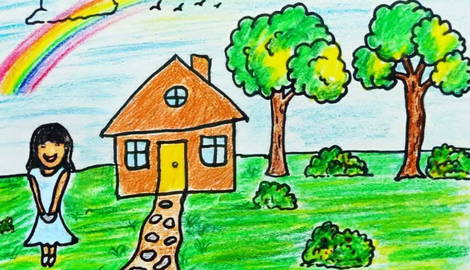
Drawing can express what words struggle to convey. Being well aware of this fact, psychologists have incorporated several drawing tests, including the HTP test (House-Tree-Person), into their clinical practice to learn more about their patients. These tests, known as Projective Drawing Techniques (PDT), are used to outline key factors of a patient’s personality, relationship to the environment, intelligence, and even traumas. But to what extent can a drawing accurately portray one’s psychological landscape?
When Did PDT Emerge in Psychology?

While there has long been interest in the relationship between drawing and psychology, Projective Drawing Techniques emerged in 1926 with the works of American psychologist Florence Goodenough. Goodenough developed the first drawing test, known as the Draw-A-Person (DAP) technique. The DAP technique was initially a method for determining a patient’s level of intelligence and a child’s mental age. The test was widely accepted as there was an evident correlation between its results and the scores of other intelligence tests. In 1963, Dale Harris evaluated and revised the test, which is why it is now known as the Goodenough-Harris technique.
Psychologists such as Julian Janes attempted to use DAP as a diagnostic tool for identifying patients with mental disorders like schizophrenia. Although Harris strongly disagreed that drawing tests can reveal anything about a patient’s personality or psychological state, proponents of the HTP test argued otherwise.
Who Developed the HTP Test?

The House-Tree-Person (HTP) test was developed by psychologist John N. Buck in 1948. According to him, the test is “a technique designed to aid the clinical in obtaining information concerning the sensitivity, maturity, and integration of a subject’s personality, and the interaction of the personality with its environment, both specific and general” (Buck, 1948). The HTP test is simultaneously a verbal and non-verbal approach to understanding the personality. During an HTP test, the subject is asked to draw a house, a tree, and a person. The prompt must be simple and non-descriptive so that the subject draws without priming. This part of the test is completely unstructured and non-verbal.
The psychologist then asks questions about the drawings, encouraging the subject to describe, define, and interpret them. For instance, the subject may be asked “Whose house is it?”, “How old is this person?”, etc. The verbal and non-verbal content of the test is then analyzed and interpreted by the psychologist.
How Are HTP Test Drawings Interpreted?

The HTP test drawings are interpreted qualitatively. The qualitative mode of analysis results in a largely subjective interpretation that varies from one analyst to another. That being said, there are several catalogs outlining some of the basic guidelines that most analysts follow. The drawing of the house typically provides insight into the patient’s family life and relationship to the environment. For instance, a drawing of a house without windows may signal personal isolation, given that windows represent one’s relationship to the outside world. The drawing of the tree reveals unconscious aspects of a patient’s psychological development, relationships, and stability.
For example, a drawing of a tree without roots suggests that the patient lacks grounding and stability. The drawing of the person represents the patient’s self-image, interpersonal relationships, and affectivity. If the person in the drawing has clenched hands, the patient may suffer from aggression problems. The features and posture of the figure are also indicative of the patient’s self-esteem.

The proportions, details, and locations of each object in a drawing are also taken into consideration during the interpretation process. Large objects in a drawing typically indicate confidence, high self-esteem, and satisfaction. For instance, a drawing of a house that is relatively small in proportion to the page suggests that the patient is unhappy with their family life. A complete lack of details suggests depression. Inversely, a very detailed drawing of a face suggests that the patient pays great attention to how they present themselves to others.
Objects drawn near the top of the page are linked to imagination while objects drawn near the bottom are connected to physical reality. Objects drawn in the center are linked to the present while objects on the right and left of the page are linked to the future and the past, respectively. Additionally, the pressure and firmness of strokes and lines in a drawing suggest confidence and determination. Several strokes on the same line suggest insecurity and perfectionism. What do you think your house, tree, and person drawings would say about you?










